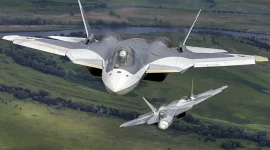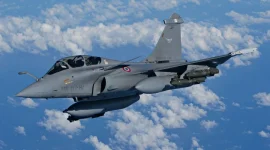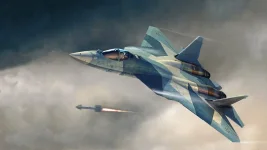- Views: 8K
- Replies: 41
The United Arab Emirates' substantial $18 billion agreement for 80 Rafale F4 fighter jets, signed in December 2021 with France's Dassault Aviation, represents the largest export order for this advanced aircraft.
This deal, including helicopters and support, has intensified discussions about the feasibility and cost-effectiveness of manufacturing the Rafale F4 in India under the nation's Atmanirbhar Bharat initiative, especially as India aims to strengthen its air and naval forces.
Using the UAE contract as a reference point, this analysis explores the potential costs and challenges of domestically producing the Rafale F4, considering India's specific defence requirements and industrial landscape.
Understanding the Benchmark: The UAE Rafale F4 Deal
The UAE's $18 billion package secures 80 Rafale F4 aircraft, alongside extensive support, logistics, training, spare parts, and weapons integration, with deliveries expected from 2027. This equates to roughly $225 million per aircraft.However, this figure includes significant non-airframe elements like munitions, maintenance infrastructure, and comprehensive support packages, which typically constitute 30-40% of such deals. Adjusting for these factors, the estimated 'flyaway cost' (the cost of the aircraft itself) for a UAE Rafale F4 likely falls between $140 million and $160 million.
The F4 variant represents a considerable advancement over the F3R standard currently operated by the Indian Air Force (IAF), featuring upgrades like enhanced Thales RBE2 AESA radar, improved electronic warfare suites, advanced sensors (including a new IRST), superior network connectivity, and integration of newer weapons like the MICA NG missile and 1,000kg AASM Hammer munitions.
Cost Factors for a "Made-in-India" Rafale F4
Establishing Rafale F4 production in India, likely involving Dassault and an Indian partner such as Hindustan Aeronautics Limited (HAL) or the existing Dassault Reliance Aerospace Limited (DRAL) venture, would face several unique cost dynamics:- Economies of Scale: The UAE's 80-aircraft order allows for cost efficiencies through large-scale production. India would need a similarly substantial order, potentially the 114 jets envisioned for the Multi-Role Fighter Aircraft (MRFA) requirement or the recently discussed additional 40 jets for the IAF, to achieve comparable per-unit pricing. Recent reports suggest India might pursue a Government-to-Government deal for these additional Rafales, potentially streamlining the process but still requiring significant volume for cost benefits in local production.
- Local Manufacturing Savings: Domestic production offers potential savings on labour and facility costs compared to France. HAL's past experience with licensed production (like the Su-30 MKI) suggests assembly and integration savings could reach 10-20%. However, critical high-technology components, particularly engines (which can account for 30-40% of a jet's cost), advanced avionics, and radar systems, would likely still be imported initially, limiting overall savings to perhaps 15-25% compared to French manufacturing.
- Technology Transfer and Setup Costs: Unlike the UAE deal, India would mandate extensive technology transfer for local production, a key point in past negotiations like the original MMRCA competition. Establishing a dedicated production line, training specialised personnel, and covering licensing fees represent significant upfront investments, estimated at $2-3 billion. Amortized over a hypothetical 100-jet run, this adds approximately $20-30 million to each aircraft's cost. Dassault has previously indicated a minimum order of 100 units would be necessary to justify setting up a full assembly line in India, potentially through an expanded DRAL facility, over which it might seek full control to ensure quality standards, recalling past disagreements during MMRCA talks regarding HAL's production.
- India-Specific Enhancements (ISE): India's initial 36 Rafales included around $2 billion worth of specific modifications (like Israeli helmet displays). A future Indian Rafale F4 would almost certainly require further customisation, such as integrating indigenous systems like the Astra missile or adapting to unique IAF/Navy operational doctrines. These enhancements could add another $15-20 million per aircraft.
- Offset Obligations: India's defence procurement policies typically mandate significant reinvestment (offsets) into the local defence industry, often 30-50% of the contract value for competitive bids, although rules differ for G2G deals. While fostering domestic industry, meeting these obligations can inflate the prime contractor's costs as they establish local partnerships and supply chains. For a deal mirroring the UAE's value, this could imply $5.4-9 billion in offset commitments, potentially adding around 10% to the overall cost structure as Dassault integrates Indian partners like L&T, Mahindra, Kalyani Group, and Godrej & Boyce further into the supply chain. However, the effectiveness of offsets in transferring high-end technology versus simple buy-backs remains a point of discussion.
Estimated Cost Scenario
Based on these factors and using the adjusted UAE flyaway cost as a starting point, a tentative cost structure for 100 "Made-in-India" Rafale F4 jets could look like this:- Base Flyaway Cost: $140 million/jet × 100 = $14 billion
- Technology Transfer/Setup: $2.5 billion (or $25 million/jet)
- India-Specific Enhancements: $1.5 billion (or $15 million/jet)
- Offset-Related Cost Inflation (est. 10%): $1.4 billion
- Support & Logistics (est. 20% of airframe cost): $3 billion
While potentially higher per unit initially than a direct import (like the 2016 deal's inflation-adjusted $122 million flyaway cost), the strategic goal involves building long-term industrial capability alongside acquiring the aircraft.
Ultimately, while local labour offers savings, the substantial costs associated with technology transfer, establishing production infrastructure, meeting offset requirements, and incorporating specific enhancements mean that a "Made-in-India" Rafale F4 might only become significantly cost-competitive with direct imports if production volumes are very large, potentially including export orders facilitated by a robust indigenous supply chain.



